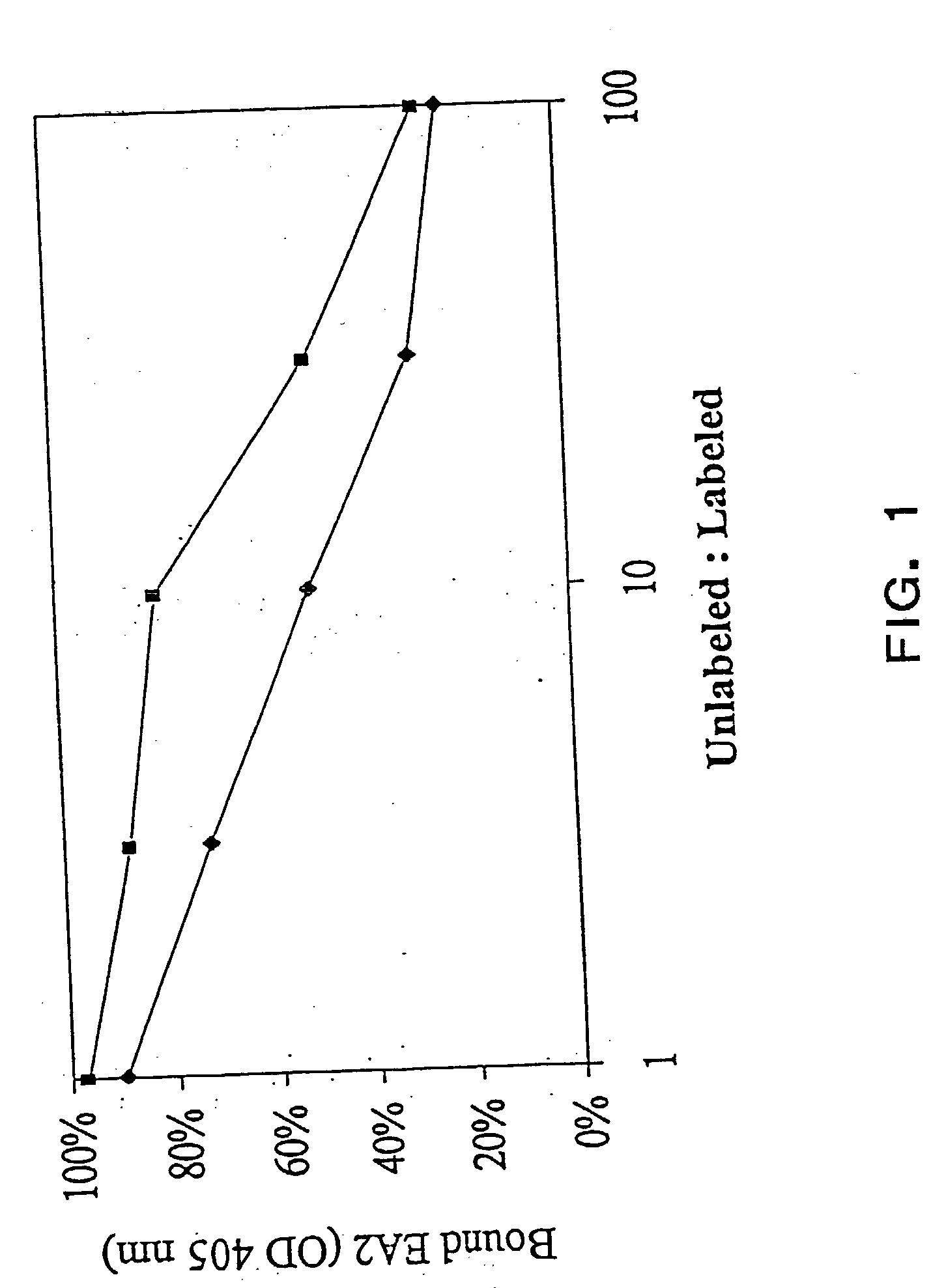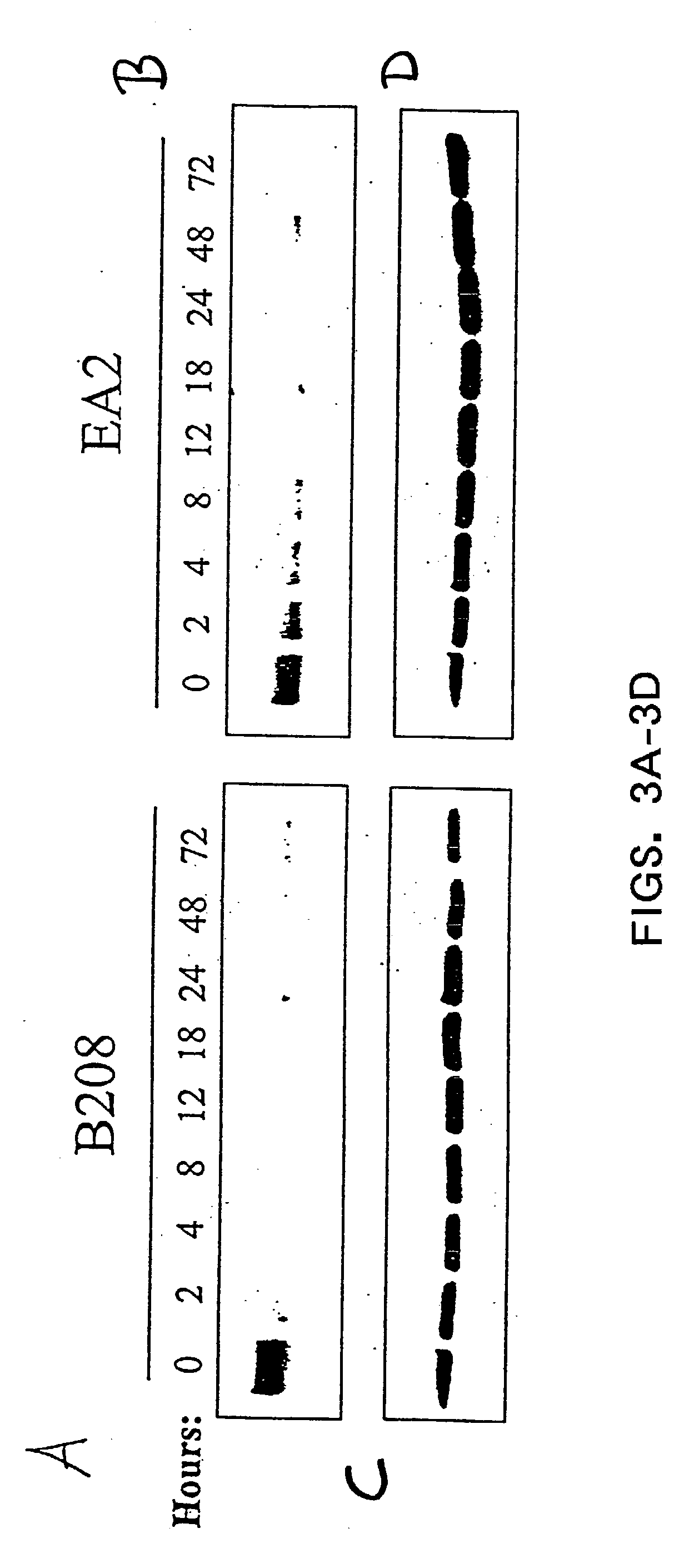[0019] EphA2 is overexpressed and functionally altered in a large number of malignant carcinomas. EphA2 is an oncoprotein and is sufficient to confer metastatic potential to cancer cells. EphA2 is also associated with other hyperproliferating cells and is implicated in diseases caused by cell hyperproliferation. EphA2 that is overexpressed on
malignant cells exhibits
kinase activity independent from ligand binding. The present inventors have found that a decrease in EphA2 levels can decrease proliferation and / or metastatic behavior of a cell. In particular, the present inventors have discovered that, surprisingly, antibodies that agonize EphA2, i.e., elicit EphA2 signaling, actually decrease EphA2 expression and inhibit tumor
cell growth and / or
metastasis. Although not intending to be bound by any
mechanism of action, agonistic antibodies may repress hyperproliferation or malignant cell behavior by inducing EphA2
autophosphorylation, thereby causing subsequent EphA2 degradation to down-regulate expression. Thus, in one embodiment, the EphA2 antibodies of the invention agonize EphA2 signaling and increase
phosphorylation of EphA2 ("EphA2 agonistic antibodies").
[0020] In addition, cancer cells exhibit phenotypic traits that differ from those of non-cancer cells, for example, formation of colonies in a three-dimensional substrate such as
soft agar or the formation of tubular networks or weblike matrices in a three-dimensional
basement membrane or
extracellular matrix preparation, such as
MATRIGEL.TM.. Non-cancer cells do not form colonies in soft
agar and form distinct sphere-like structures in three-dimensional
basement membrane or
extracellular matrix preparations. Accordingly, the invention also provides antibodies that specifically bind EphA2 and inhibit one or more
cancer cell phenotypes, such as
colony formation in soft
agar or
tubular network formation in three-dimensional
basement membrane or
extracellular matrix preparations ("
cancer cell phenotype inhibitory EphA2 antibodies"). Exposing cancer cells to such cancer
cell phenotype inhibitory EphA2 antibodies prevents or decreases the cells' ability to colonize or form tubular networks in these substrates. Furthermore, in certain embodiments, the addition of such cancer
cell phenotype inhibitory EphA2 antibodies to already established colonies of cancer cells cause a reduction or
elimination of an existing cancer cell colony, i.e., leads to killing of hyperproliferative and / or metastatic cells, for example through
necrosis or
apoptosis.
[0021] Differences in the
subcellular localization, ligand
binding properties or
protein organization (e.g., structure, orientation in the
cell membrane) can further distinguish the EphA2 that is present on cancer cells from EphA2 on non-cancer cells. In non-cancer cells, EphA2 is expressed at low levels and is localized to sites of cell-
cell contact, where it can engage its membrane-anchored ligands. However, cancer cells generally display decreased cell-cell contacts and this can decrease EphA2-ligand binding. Furthermore, the overexpression of EphA2 can cause an excess of EphA2 relative to ligand that increases the amount of non-ligand bound EphA2. Consequently, changes in the subcellular distribution or membrane orientation of EphA2 can cause EphA2 to localize to sites in a cancer cell where it is inaccessible to ligand. Additionally, EphA2 may have altered ligand
binding properties (e.g., due to an altered conformation) in cancer cells such that it is incapable of stable interactions with its ligand whether or not it is localized to the cell-
cell junction. In each case, these changes can
expose certain epitopes on the EphA2 in cancer cells that are not exposed in non-cancer cells. Accordingly, the invention also provides antibodies that specifically bind EphA2 but preferably bind an EphA2
epitope exposed on cancer cells but not on non-cancer cells ("exposed EphA2
epitope antibodies"). Exposing cancer cells to such EphA2 antibodies that preferentially bind epitopes on EphA2 that are selectively exposed or increased on cancer cells but not non-cancer cells targets the therapeutic / prophylactic
antibody to cancer cells and prevents or decreases the cells' ability to proliferate while sparing non-cancer cells.
[0022] The present inventors have also found that antibodies that bind EphA2 with a very low K.sub.
off rate are particularly effective to reduce EphA2 expression and / or induce EphA2 degradation and, thereby, inhibit tumor
cell growth and / or
metastasis and / or proliferation of hyperproliferative cells. Accordingly, the invention further provides antibodies that bind EphA2 with a K.sub.off of less than 3.times.10.sup.-3 s.sup.-1 and, preferably, are EphA2 agonists.
[0027] The methods and compositions of the invention are useful not only in untreated patients but are also useful in the treatment of patients partially or completely
refractory to current standard and experimental cancer therapies, including but not limited to chemotherapies, hormonal therapies,
biological therapies,
radiation therapies, and / or
surgery as well as to improve the
efficacy of such treatments. In particular, EphA2 expression has been implicated in increasing levels of the
cytokine IL-6, which has been associated with the development of cancer
cell resistance to different treatment regimens, such as
chemotherapy and hormonal therapy. In addition, EphA2 overexpression can override the need for
estrogen receptor activity thus contributing to
tamoxifen resistance in
breast cancer cells. Accordingly, in a preferred embodiment, the invention provides therapeutic and prophylactic methods for the treatment or prevention of cancer that has been shown to be or may be
refractory or non-responsive to therapies other than those comprising administration of EphA2 antibodies of the invention. In a specific embodiment, one or more EphA2 antibodies of the invention are administered to a patient
refractory or non-responsive to a non-EphA2-based treatment, particularly
tamoxifen treatment or a treatment in which resistance is associated with increased IL-6 levels, to render the patient non-refractory or responsive. The treatment to which the patient had previously been refractory or non-responsive can then be administered with
therapeutic effect.
 Login to View More
Login to View More 


